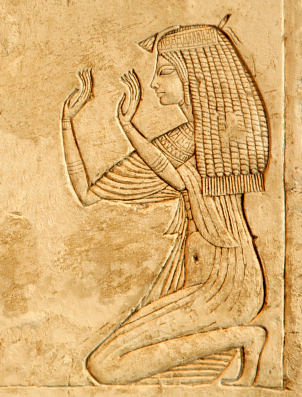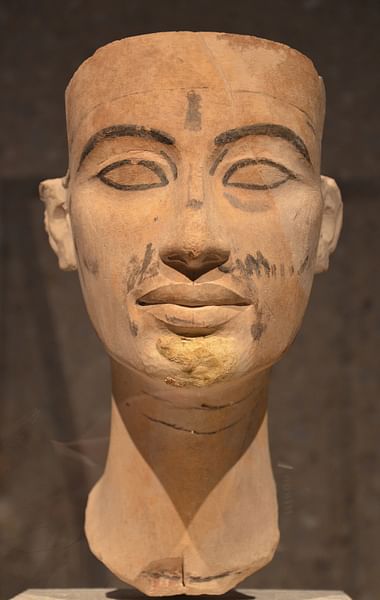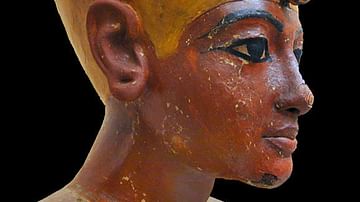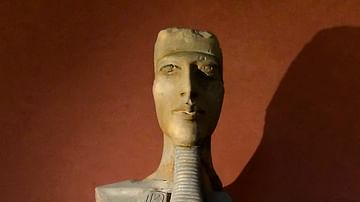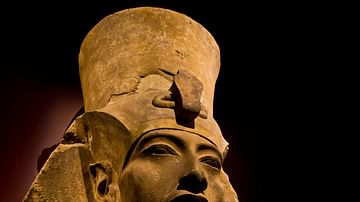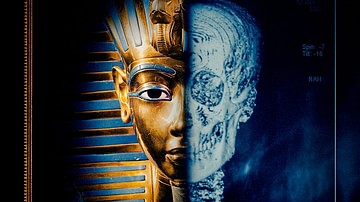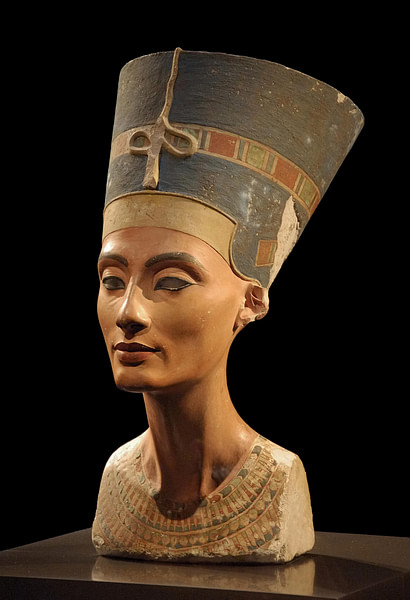
Nefertiti (c. 1370 - c. 1336 BCE) was the wife of the pharaoh Akhenaten of the 18th Dynasty of Egypt. Her name means, `the beautiful one has come' and, because of the world-famous bust created by the sculptor Thutmose (discovered in 1912 CE), she is the most recognizable queen of ancient Egypt.
She grew up in the royal palace at Thebes, probably the daughter of the vizier to Amenhotep III, a man named Ay, and was engaged to his son, Amenhotep IV, around the age of eleven. There is evidence to suggest that she was an adherent of the cult of Aten, a sun deity, at an early age and that she may have influenced Amenhotep IV's later decision to abandon the worship of the gods of Egypt in favor of a monotheism centered on Aten. After he changed his name to Akhenaten and assumed the throne of Egypt, Nefertiti ruled with him until his death after which she disappears from the historical record.
Youth & Marriage
Even though it appears that Nefertiti was the daughter of Ay, this claim is far from substantiated. Inscriptions refer to Ay's wife, Tiye (or Tey) as Nefertiti's wet nurse, not her mother, and nothing is known of Ay's lesser wife. Ay, in addition to his other duties, was tutor to the young Amenhotep IV and may have introduced the prince to Nefertiti when both were children. Nefertiti and her sister, Mudnodjame, were certainly regular members of the court at Thebes and, whether or not Ay introduced her to Amenhotep IV, the two would have known each other simply for that reason.
Ancient images and inscriptions indicate her early interest in the cult of Aten but, as every Egyptian favored one god or another, there is no reason to believe that she had any ideas relating to monotheism or elevating Aten above the other gods (as has been suggested by some scholars). All that can be stated with certainty is that both sisters were adherents of Aten and may have influenced Amenhotep IV's interest in that cult from an early age. Any definitive statements regarding her influence on the rise of monotheism in Egypt must of necessity be speculative as there is no conclusive evidence to support it; just as there is little information on her life in general. The historian Peter B. Heller notes:
What is so striking about Nefertiti's life and work is that, even though her likeness – derived from Thutmose's bust of her – is one of the best-known and most frequently reproduced in the world, and while she lived at a time when Egypt was the most cultured and most powerful nation on earth, remarkably little is known about her. (3)
By the time she was fifteen years old she was married to Amenhotep IV and, after the death of Amenhotep III, she became queen of Egypt. It is at this stage that some scholars claim she most exerted her influence on Amenhotep IV to abandon the ancient religion of Egypt and initiate his religious reforms but, again, this is unsubstantiated.
Nefertiti & Akhenaten
In the fifth year of his reign (some sources claim the ninth), Amenhotep IV changed his name to Akhenaten, abolished the religious practices of Egypt, closed the temples, and decreed Aten the one true god. While it is possible he created monotheism out of a genuine religious conviction, it is more probable that it was a political manoeuver to cut the power and wealth of the priests of the god Amun, whose cult was extremely popular.
Throughout the 18th dynasty the cult of Amun had increasingly grown in wealth and prestige so that, by Akhenaten's time, the cult's priests were almost as powerful as pharaoh. Instituting monotheism, and proscribing the old religion, would have completely restored power to the throne; and that is precisely what it did. The god Aten was now considered not only a powerful god of Egypt but the god of creation, the one true god of the universe.
Nefertiti appears with Akhenaten,
...at the site of Akhetaten (Amarna), the new city dedicated to the god Aten. In the sixth year [of Akhenaten's reign] Nefertiti's name was changed to Nefernefruaten which means `Beautiful in beauty is Aten'. Nefertiti lived with Akhenaten in Amarna where he conducted religious services to Aten. (Bunson, 185)
The couple had six daughters: Meritaten, Meketaten, Ankhesenpaaten, Nefernefruaten-tasherit, Neferneferure, and Setepenre, but no sons. With his lesser wife, Kiya, Akhenaten had two sons, Tutankhamun and possibly Smenkhkare (though Smenkhare's lineage is disputed). Akhenaten married two of these daughters, Meritaten and Ankhesenpaaten (later, Ankhsenamun, wife of Tutankhamun) and may have had children with them (though this is also disputed). What is clear, however, from stele and inscriptions which survived the later purge of their reign, is that the royal couple was deeply devoted to each other and constantly together or with their daughters. Regarding Nefertiti's physical appearance at this time, Heller writes:
It is surmised that she must have been about four feet, six inches tall, the height of an average Egyptian woman of the time. It is known from her depictions that she often went about scantily dressed, as was customary in the warm climate. Otherwise, she appeared in the traditional garb of a clinging gown tied by a girdle with ends falling in front; at times, she is depicted coiffed with a short wig. She probably had a shaven head to improve the fit of her unusual tall blue crown. It is known that she identified with her husband's heresy and that, according to Akhenaten's poetry, he loved her dearly. It is also known that her beauty was legendary. (3)
The royal family originally lived at the palace of Malkata in Thebes, which was built under the reign of Amenhotep III but renovated under Akhenaten and re-named Tehen Aten (meaning `the splendor of Aten). The historian Barbara Watterson describes the palace:
The royal apartments were built on an especially grand scale: the king's bedroom, for example, measured nearly 8 metres by 5 [26 feet by 16.5], and this excludes a raised recess to house the royal bed. The floor in the great hall of the king's palace was painted to represent a pool in the marshes and that in the palace next door a pool with plants and water birds. The entire ceiling of the great hall was patterned with flying vultures; that of the king's bedroom with a row of vultures. The ceilings of many rooms in the palace were painted with spirals and interweaving designs, combined with naturalistic forms such as flying birds. (151)
Watterson, and others, also point out that the palace was abundant in gold decorations and ornate reliefs. However opulent Malkata was, the new palace at the city the couple founded, Akhetaten, was even grander and, more importantly, served a symbolic purpose in the new religion of Aten. The Egyptologist Zahi Hawass explains:
As part of his religious revolution, Akhenaten decided to leave Thebes and move to a virgin site that would be dedicated to his new cult. The new city was located in Middle Egypt, and called Akhetaten, `Horizon of Aten'. It was laid out parallel to the river, its boundaries marked by stelae carved into the cliffs ringing the site. The king himself took responsibility for its cosmologically significant master plan. In the center of his city, the king built a formal reception palace, where he could meet officials and foreign dignitaries. The palaces in which he and his family lived were to the north, and a road led from the royal dwelling to the reception palace. Each day, Akhenaten and Nefertiti processed in their chariots from one end of the city to the other, mirroring the journey of the sun across the sky. In this, as in many other aspects of their lives that have come to us through art and texts, Akhenaten and Nefertiti were seen, or at least saw themselves, as deities in their own right. It was only through them that the Aten could be worshipped: they were both priests and gods. (39)
In her role as part of the divine couple, Nefertiti may also have been co-regent. Akhenaten joined his cartouche (his seal) with hers as a sign of equality and there is evidence that she took on the traditional duties of pharaoh while her husband busied himself with theological reformation and architectural renovations. Images which have survived depict her officiating at religious services, receiving foreign dignitaries, moderating diplomatic meetings, and even in the traditional royal role of the king smiting the enemies of Egypt.
None of these images would have been created if there were not some truth behind the stories they depict and so Nefertiti must have wielded more power than any woman in Egypt since the time of Hatshepsut (1479-1458 BCE). From the royal palace at Akhetaten, she sent forth the royal decrees and made the decisions which, according to tradition, were the responsibility of her husband.
Nefertiti's Disappearance
Around the year 14 of Akhenaten and Nefertiti's reign, their daughter Mekitaten died in childbirth at the age of 13. An image in relief from the time shows the couple standing over their daughter's body in mourning. Shortly after this, Nefertiti vanishes from the historical record. There have been many theories offered to explain her abrupt disappearance and, among these are:
- She fell out of favor with her husband because she could not produce a male heir and so was replaced by Kiya.
- She abandoned the religion of Aten and was banished by Akhenaten.
- She committed suicide in grief over the loss of her daughter.
- She continued to rule under the name of Smenkhkare until her step-son, Tutankhamun, was old enough to assume the throne.
Of these theories, none of them can be substantiated but the fourth, and even that, many argue, is uncertain. The leading proponent of the Nefertiti-as-Smenkhkare theory is Zahi Hawass who writes:
This king [Smenkhkare] is shown as a male in the company of Meritaten as `his' queen; however, his throne name was virtually identical to that of Akhenaten's coregent, now convincingly identified as Nefertiti. Whether this king was Nefertiti herself or an otherwise unattested son of Akhenaten's (or Amenhotep III's) he or she died only two years after ascending the throne, and left Egypt in the hands of a young boy named Tutankhaten [later Tutankhamun]. (47)
The problems with the other theories are that Akhenaten already had a male heir in Tutankhamun and so would not have deserted his wife on that account (theory one); there is no evidence to support Nefertiti leaving the cult of Aten (theory two); she was still living after the death of her daughter and the throne name of Akhenaten's successor is the same as hers (theory three). The reason why theory two has long remained popular is because of evidence that the worship of the old gods began to revive toward the end of Akhenaten's reign and, it is thought, this could not have happened without some kind of royal support or encouragement.
Since it is considered impossible that Akhenaten would have abandoned the religion he created, it is speculated that it was his coregent who was behind this. The revival of the old religious practices, however, could easily have been a grassroots movement by the people of Egypt who had grown tired of being forced to neglect the traditional faith of the land. The Egyptians held that their actions were intimately tied to celestial balance and that their relationship with the gods was of vital importance.
In abandoning the old gods of Egypt, Akhenaten would have thrown the universe out of balance and it is quite likely that the former priests of Amun, and those of other cults, finally decided to try to restore harmony to the land on their own, without consulting their ruler. Since it is known that Nefertiti was a devotee of Aten prior even to Akhenaten's conversion, and that she regularly took part in religious services, as well as the fact that no images or inscriptions give any evidence that she forsook the cult, it is highly unlikely that she would have led a return to the traditional religious practices of Egypt.
The hatred the people had for the new monotheistic religion of their pharaoh is exemplified in its complete eradication after the death of Akhenaten's successor Tutankhamun. Tutankhamun himself, upon taking the throne, abandoned the religion of Aten and returned Egypt to traditional practice. His successor, Ay, (possibly the same man suggested as Nefertiti's father) continued his policies but the last pharaoh of the 18th dynasty, Horemheb, went further than either of them.
Horemheb, claiming he had been chosen by the gods to restore the true religion of Egypt, tore down Akhenaten's temples, defaced his stele, and tried to eradicate all evidence that the heretic king and his family had ever ruled Egypt. It is because of Horemheb' s decrees that so little is known of Nefertiti, and other royals linked with the Amarna Period, in the present day. The wonder, really, is not that so little is known but that, considering Horemheb's hatred of Akhenaten's reforms, and his dedication to the mission of erasing the king and his family from history, that modern day scholars have any information on the Amarna Period at all.
Modern-day Controversy
Nefertiti was the subject of controversy, between Egypt and England, when the British archaeologist, Joann Fletcher, claimed to have found the queen's mummy in 2003 CE. Fletcher's claim was based on details of a mummy, known by Egyptologists as the “Younger Lady”, which she felt matched depictions of Nefertiti. The Discovery Channel aired Fletcher's theory as though the mummy of the queen had been positively identified when, in fact, this was hardly the case. As a result, Fletcher was banned from working in Egypt because of an alleged breach in protocol which requires all archaeologists working in the country to first report their findings to the Supreme Council of Antiquities before releasing anything to the international press.
Although this ban was later lifted, and Fletcher returned to Egypt, the controversy surrounding the mummy is unresolved. Fletcher's supporters claim that the “Younger Lady” is Nefertiti while those who side with Hawass maintain the opposite. The very same details are used by both sides to support their claim and it seems unlikely there will be any resolution until some future discovery is made which lends more weight to one side than the other.
Nefertiti has also caused an on-going dispute between Egypt and Germany over the famous bust presently residing in the Egyptian Museum (Neues Museum) of Berlin. Nefertiti's face is one of the most instantly recognizable images from antiquity, perhaps, only second to her step-son Tutankhamun. Even if one does not know the queen's name, statuettes and posters of the famous bust have been reproduced world-wide.
Even so, when it was discovered in 1912 CE, no one knew who Nefertiti was. The bust would have been remarkable for its beauty, of course, but not for the individual it represents. Because of the decrees of Horemheb, the royal family had been forgotten. Inscriptions from Horemheb's reign show him as the successor of Amenhotep III, completely erasing the reign of the `heretic king' and his successors. The bust was created c. 1340 BCE by the court sculptor Thutmosis as a model for his apprentices in their representations (whether sculpture or painting) of the queen. Because it was a model, and never intended for display, only one eye is completed.
The Egyptian Museum of Berlin describes the Bust of Queen Nefertiti as “one of the first ranking works of Egyptian art mostly due to the excellent preservation of the colour and the fine modeling of the face…the bust is made of limestone which is covered with modeled gypsum. The eye is inlayed with crystal and the pupil attached with black coloured wax. The second eye-inlay was never carried out” (1).
The bust is housed in Room 2.10 of the Egyptian Museum of Berlin in Germany where it was taken after its discovery at Amarna. Hawass writes, “One day in the winter of 1912 CE, a German archaeologist named Ludwig Borchardt was excavating at Tell al-Amarna when he found a beautiful bust of Nefertiti in the workshop of a sculptor named Thutmosis” (39). What happened after this discovery is an ongoing, often heated, debate between Egypt and Germany.
Since the enforcement of the rules governing antiquities in Egypt was fairly lax in the early 20th century CE (as, in some areas anyway, were the rules themselves) it does not seem there can ever be any way to resolve the dispute. The Germans claim that Borchardt found the bust, made a legal declaration of his find, and then brought the piece back to Germany. The Egyptian claim (as articulated by Hawass) argues that “the German mission covered the head with mud to disguise its beauty so that during the division of antiquities at the Egyptian Museum in Cairo the curator did not notice its remarkable features. Therefore, the bust was allowed to go to the Berlin Museum” (39).
The Egyptians, then, claim the bust was obtained illegally and should be returned to Egypt; the Germans, of course, argue it is their legal property and should remain in the museum. Hawass notes that, “Plans were made to return [the bust] to Egypt just before World War II, but Hitler asked to see it before it left the country, fell in love with it, and refused to let it out of German hands” (41). This claim has also been disputed by the German government and the former, and current, director of the Egyptian Museum of Berlin.
In 2003 CE this controversy became more heated when the museum allowed two artists, known as Little Warsaw, to place the bust on a bronze body of a naked woman in order to show what the queen may have looked like. This very poor decision resulted in Egypt renewing its efforts for repatriation of the bust but, as the Little Warsaw exhibit lasted only a few hours, the controversy cooled and the bust remains where it has been since 1913 CE and where it continues to be one of the most popular pieces of art, if not the most popular, in the permanent collection.
